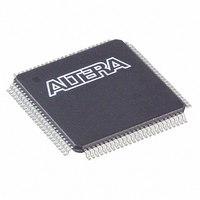EPM570T100C3N Altera, EPM570T100C3N Datasheet - Page 24

EPM570T100C3N
Manufacturer Part Number
EPM570T100C3N
Description
IC MAX II CPLD 570 LE 100-TQFP
Manufacturer
Altera
Series
MAX® IIr
Specifications of EPM570T100C3N
Programmable Type
In System Programmable
Delay Time Tpd(1) Max
5.4ns
Voltage Supply - Internal
2.5V, 3.3V
Number Of Logic Elements/blocks
570
Number Of Macrocells
440
Number Of I /o
76
Operating Temperature
0°C ~ 85°C
Mounting Type
Surface Mount
Package / Case
100-TQFP, 100-VQFP
Voltage
2.5V, 3.3V
Memory Type
FLASH
Number Of Logic Elements/cells
570
Family Name
MAX II
# Macrocells
440
Frequency (max)
3.01205GHz
Propagation Delay Time
5.4ns
Number Of Logic Blocks/elements
57
# I/os (max)
76
Operating Supply Voltage (typ)
2.5/3.3V
In System Programmable
Yes
Operating Supply Voltage (min)
2.375V
Operating Supply Voltage (max)
3.6V
Operating Temp Range
0C to 85C
Operating Temperature Classification
Commercial
Mounting
Surface Mount
Pin Count
100
Package Type
TQFP
Lead Free Status / RoHS Status
Lead free / RoHS Compliant
Features
-
Lead Free Status / Rohs Status
Compliant
Other names
544-1315
EPM570T100C3N
EPM570T100C3N
Available stocks
Company
Part Number
Manufacturer
Quantity
Price
Part Number:
EPM570T100C3N
Manufacturer:
ALTERA/阿尔特拉
Quantity:
20 000
2–16
Table 2–2. MAX II Device Routing Scheme
Global Signals
MAX II Device Handbook
LUT Chain
Register Chain
Local
Interconnect
DirectLink
Interconnect
R4 Interconnect
C4 Interconnect
LE
UFM Block
Column IOE
Row IOE
Note to
(1) These categories are interconnects.
Source
Table
2–2:
Chain
LUT
v
—
—
—
—
—
—
—
—
—
The UFM block communicates with the logic array similar to LAB-to-LAB interfaces.
The UFM block connects to row and column interconnects and has local interconnect
regions driven by row and column interconnects. This block also has DirectLink
interconnects for fast connections to and from a neighboring LAB. For more
information about the UFM interface to the logic array, see
Block” on page
Table 2–2
Each MAX II device has four dual-purpose dedicated clock pins (GCLK[3..0], two
pins on the left side and two pins on the right side) that drive the global clock network
for clocking, as shown in
purpose I/O if they are not used to drive the global clock network.
The four global clock lines in the global clock network drive throughout the entire
device. The global clock network can provide clocks for all resources within the
device including LEs, LAB local interconnect, IOEs, and the UFM block. The global
clock lines can also be used for global control signals, such as clock enables,
synchronous or asynchronous clears, presets, output enables, or protocol control
signals such as TRDY and IRDY for PCI. Internal logic can drive the global clock
network for internally-generated global clocks and control signals.
the various sources that drive the global clock network.
Register
Chain
v
—
—
—
—
—
—
—
—
—
shows the MAX II device routing scheme.
Local
2–18.
(1)
—
—
v
v
v
v
v
—
—
—
DirectLink
Figure
(1)
v
v
v
—
—
—
—
—
—
—
2–13. These four pins can also be used as general-
R4
—
—
—
—
v
v
v
v
—
v
(1)
Destination
C4
v
v
v
v
v
v
—
—
—
—
(1)
v
v
v
—
—
—
—
—
—
—
LE
“User Flash Memory
Block
© October 2008 Altera Corporation
UFM
v
—
—
—
—
—
—
—
—
—
Chapter 2: MAX II Architecture
Figure 2–13
Column
IOE
v
v
—
—
—
—
—
—
—
—
Global Signals
Row
IOE
v
—
—
v
—
—
—
—
—
—
shows
Fast I/O
(1)
—
—
—
—
—
—
v
—
—
—














